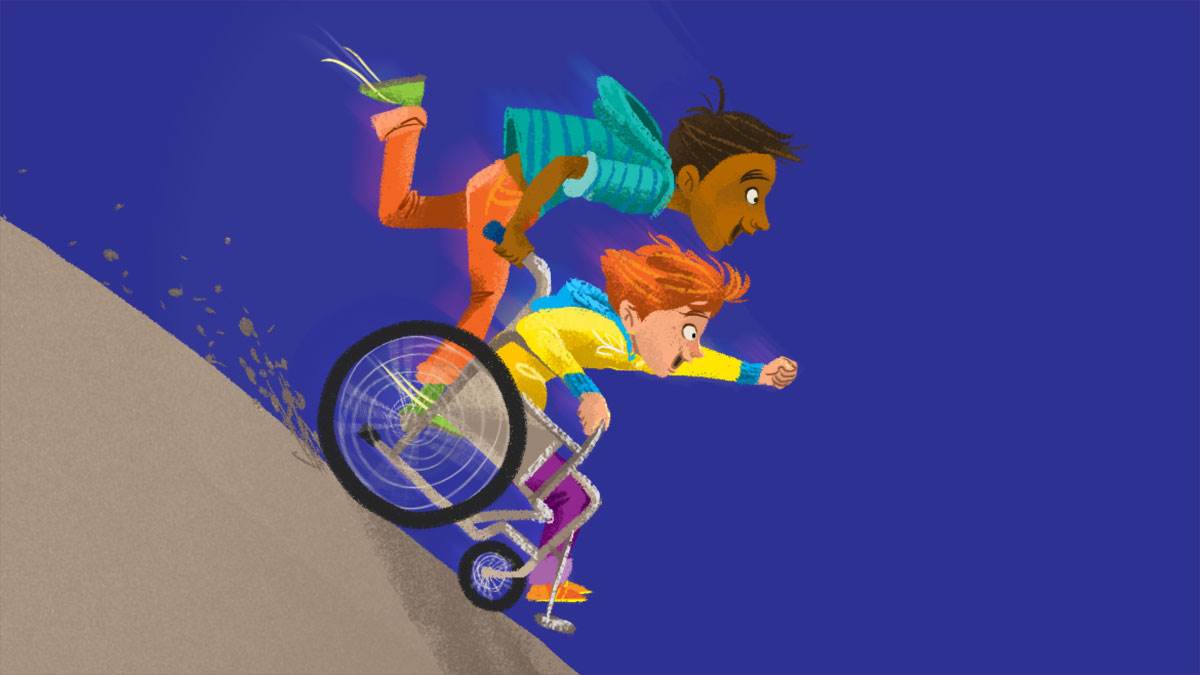The One in the Wheelchair – a look at children's books and disability
Published on: 03 December 2018 Author: Dr Rebecca Butler
Characters in wheelchairs certainly play a more prominent role in children’s books than they once did. As an academic and full-time wheelchair user, Dr Rebecca Butler looks at a few books that present wheelchair users very differently. What can we learn from them?

The manual wheelchair user
In Tom Fletcher’s The Christmasaurus, a boy of ten, William, is the user of a manual wheelchair. He has the upper body strength to propel his own chair. In this chair, William goes on adventures with Santa and a live dinosaur. He saves Christmas from destruction by an evil hunter. Fletcher’s positive note is to encourage the reader to see the chair not as an encumbrance or a burden but as the device that allows the boy to travel on these amazing adventures. The boy himself is the protagonist of the story – thanks to the chair, his disability does not disqualify him from that role – and the whole narrative unfolds from his point of view.
The part-time wheelchair user
The protagonist of Truly, Wildly, Deeply by Jenny McLachlan is Annie, a part-time wheelchair user. For short distances, she can walk but uses a manual wheelchair for longer trips. McLachlan demonstrates that even using a wheelchair part-time can have complex repercussions. Out with her boyfriend in the snow, Annie leaves her wheelchair behind and moves ahead on foot. But she finds that the snow immobilises her and has to ask her friend to piggyback her to the chair. Like any mechanical aid, the chair can pose a problem.
The modern day take on a classic
One of today’s most distinguished authors, Jacqueline Wilson, turned her hand in 2015 to reworking a classic book. The classic was What Katy Did by Susan Coolidge, published in 1872. Coolidge’s work, popular as it remains, contains some famously inappropriate passages. When Katy becomes disabled, for example, her saintly cousin Helen tells her that she is in ‘God’s school of pain’. In Katy, Wilson turns the story through two different directions. First, she charts Katy’s gradual acceptance of disability and what it means. Second, she provides a carefully researched account of the treatment, medical and social, that Katy receives. The resulting story is uplifting but also in touch with the realities of the medical treatment and Katy’s feelings.
The rarely seen powered wheelchair
A seminal book about wheelchairs, Out of My Mind, comes from the USA in the hands of Sharon M Draper. Melody Brooks is in her last year at primary. She is a full-time user of a powered (i.e. battery driven) wheelchair. She is also aphasic – she does not speak. She occupies the lowest grades for all her subjects, still (the teachers think) learning ABC at age nine. Then a teacher gets the school to install a voice synthesiser on her chair.
Melody is liberated. She quickly ascends to the top of the academic ladder and becomes a star of the school debating society. From now on, she drives her wheelchair with massive confidence through the school. Draper’s grip on the complexities of a disabled child’s life is firm and accurate. The transformative influence of the speech device is depicted with utter conviction.
Where does this leave us?
Melody is surely an exception to a general rule about disabled characters in children’s books. Few of them use powered chairs. Do writers shy away from the technical knowledge needed to depict a powered chair? Very few disabled characters in children’s books are grown up. They are mostly children or the very aged. How are young readers meant to understand the position of an adult in a wheelchair if no literary examples exist?
There is certainly, however, much to celebrate. Not least the fact that modern novelists all avoid the trap into which their Victorian and Edwardian predecessors fell – the pitfall of the miraculous cure!
The most infamous example of course is Pollyanna (1913), instantly "cured" by a doctor whose only stated talent was smiling a lot.
So here’s hoping that the future sees an even more diverse and realistic range of depictions of wheelchair users in children’s books.
Topics: Bookmark, Disability, Mobility/wheelchair, Features






Add a comment